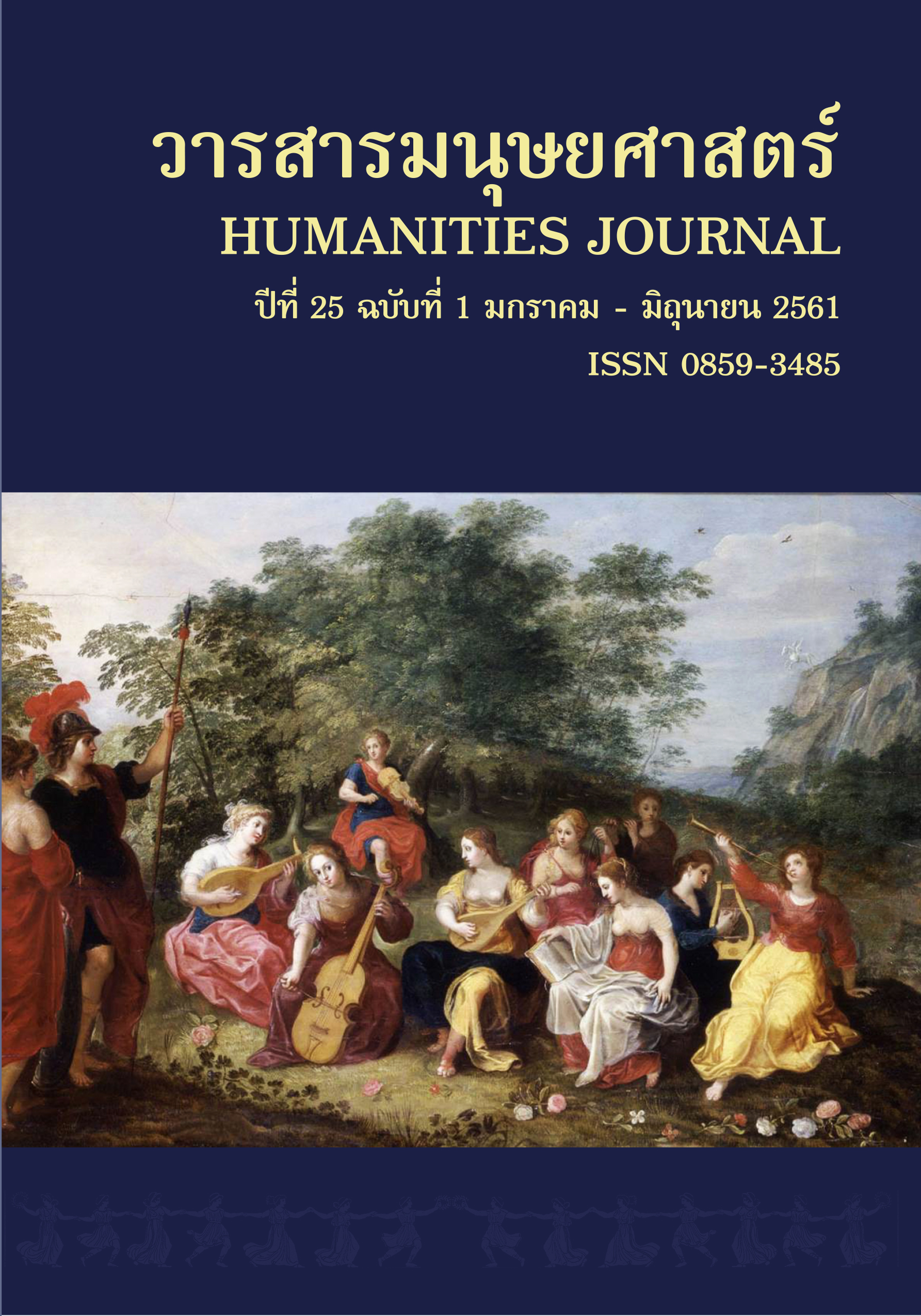Teachers’ Attitudes towards the Use of Graded Readers in Promoting English Reading Skills in Thai EFL Students A Case Study of Secondary School Teachers in Bangkok
Main Article Content
บทคัดย่อ
งานวิจัยนี้มุ่งเน้นศึกษาการใช้หนังสืออ่านนอกเวลาภาษาอังกฤษของนักเรียนระดับชั้นมัธยมศึกษาของไทย และเพื่อสารวจทัศนคติของครูผู้สอนวิชาภาษาอังกฤษต่อการใช้หนังสืออ่านนอกเวลาเพื่อพัฒนาทักษะการอ่านภาษาอังกฤษ ผู้ให้ข้อมูลจานวนทั้งหมด 45 คน เป็นครูประจาภาควิชาภาษาต่างประเทศจาก 6 โรงเรียนในกรุงเทพมหานครที่อยู่ภายใต้การควบคุมของสานักงานการศึกษา ขั้นพื้นฐาน (สพฐ.) ซึ่งได้บรรจุหนังสืออ่านนอกเวลาภาษาอังกฤษในหลักสูตรของโรงเรียน การเก็บข้อมูลของงานวิจัยนี้ใช้แบบสอบถามและการสัมภาษณ์เป็นเครื่องมือหลัก และการวิเคราะห์เนื้อหาใช้วิธีการเชิงบรรยายและการตีความภายใต้กรอบทฤษฎีที่เกี่ยวข้อง จากการศึกษาพบว่า 47% ของครูในโรงเรียนดังกล่าวใช้หนังสือนอกเวลาเป็นการอ่านเสริมนอกห้องเรียน โดยมีวัตถุประสงค์หลักเพื่อส่งเสริมนิสัยรักการอ่าน และให้นักเรียนมีโอกาสอ่านหนังสือภาษาอังกฤษที่หลากหลายและเหมาะสมกับระดับความสามารถทางภาษาอังกฤษของตนมากขึ้น ตามนโยบายของโรงเรียน แต่ไม่ตระหนักถึงความสาคัญในการนาหนังสืออ่านนอกเวลามาใช้เพื่อพัฒนากลวิธีการอ่าน อย่างไรก็ตาม 53% ของครูในโรงเรียนดังกล่าวนาหนังสืออ่านนอกเวลามาใช้ในห้องเรียนเพื่อการพัฒนากลวิธีการอ่าน และจากผลสารวจพบว่า ครูเหล่านั้นรายงานการสอนการอ่านโดยใช้หนังสือนอกเวลาเป็นเครื่องมือในการพัฒนา กลวิธีด้านการอ่าน 8 กลวิธีเป็นหลัก เมื่อพิจารณาถึงทัศนคติโดยรวมของครูผู้สอนการอ่านในโรงเรียนเหล่านี้ ผลวิจัยบ่งบอกว่า โรงเรียนควรจะได้มีการพัฒนาส่งเสริมการสอนการอ่านแก่ผู้สอน ซึ่งรวมถึงการนาหนังสืออ่านนอกเวลามาใช้พัฒนากลวิธีการอ่านก็จะช่วยส่งเสริมให้การพัฒนาการอ่านของผู้เรียนมีประสิทธิภาพยิ่งขึ้น
Article Details
เอกสารอ้างอิง
Anderson, N. J. (1999). Exploring Second Language Reading: Issues and Strategies. Toronto, Canada: Heinle and Heinle.
Bailey, E. (2014). Making inferences: Improving reading comprehension for students with dyslexia. Retrieved from https://www.thoughtco.com/making-inferences-3111201.
Baker, W. (2012). English as a Lingua Franca in Thailand: Characterisations and implications. Englishs in Practice: Working Papers of the Centre for Global Englishes, 1(1), 18-27.
Beale, A. M. (2013). Skimming and scanning: Two important strategies for speeding up your reading. Retrived from https://www.howtolearn.com/2013/02/ skimming-and-scanning-two-important-strategies-for-speeding-up-your-reading/.
Berg, B. (2004). Qualitative Research Methods for the Social Sciences (5th ed.). USA: Pearson.
Bulushy, Z. A. (n.d.). The story behind Graded Readers. Retrieved from https://www.developingteachers.com/articles_tchtraining/graded1_zainab.htm
Carrell, P. L. (1989). Metacognitive Awareness and Second Language Reading. The Modern Language Journal, 73(2), 121-134.
Chawwang, N. (2008). An investigation of English reading problems of Thai 12th-grade students in Nakhonratchasima educational regions 1, 2, 3, and 7 (Master’s thesis). Srinakharinwirot University, Bangkok.
Chinwonno, A. (2001). A Comparison of Thai and English Reading Comprehension Strategies of Preservice Teacher in Thailand (Doctoral dissertation). Ohio University, USA.
Coffey, A., & Atkinson P. (1996). Making Sense of Qualitative Data: Complementary Research Strategies. Thousand Oaks, CA: Sage.
Creswell, J. (2009). Research Design: Qualitative, Quantitative, and Mixed Methods Approaches. (3rd ed.). California: Sage Publication.
Duffy, G. G. (2003). Explaining Reading: A Resource for Teaching Concepts, Skills, and Strategies. New York, NY: The Guilford press.
Duke, N. K., & Pearson, P. D. (2002). Effective practices for developing reading Comprehension. In A. E. Farstup & S. J. Samuels (Eds.), What research has to say about reading instruction (pp. 205-242). Retrieved from https://diagnosisfall2010.wikispaces.com/file/view/Duke+Pearson+ Comprehension.pdf.
Education Service Agencies region 6 & 7. (2006). On Target: Strategies to build student vocabularies. Retrieved from https://celi.olemiss.edu/wp-content/uploads/ sites/7/2014/01/ StrategiesVocabulary-080808.pdf.
Ghabanchi, Z., & Behrooznia, S. (2014). The impact of brainstorming on reading comprehension and critical thinking ability of EFL learners. Procedia-Social and Behavioral Sciences. 98, 513-521. Retrieved from https://www.sciencedirect.com/science/article/pii/S1877042814025385.
Herrmann, E. (2013). Background knowledge: Why is it important for ELL programs? Retrieved from https://www.multibriefs.com/briefs/exclusive/background _knowledge_1.html#.WPh-tfmGOUl.
Irwin, J. W. (1986). Teaching Reading Comprehension Processes. Englewood Cliffs, NJ: Prentice Hall.
Johnson, D., & Blair, A. (2003). The importance and use of student self-selected literature of reading engagement in an elementary reading curriculum. Reading Horizons, 43(3), 181-202.
Jones, R. (2012). Strategies for Reading Comprehension: Summarizing. Retrieved from https://www.readingquest.org/strat/summarize.html.
Kleinová, D. (2015). Graded Readers as a Tool to Raise Learners' Interest in Reading (Master’s thesis). Masaryk University, Czech Republic.
Kragler, S. (2000). Choosing books for reading: An analysis of three types of readers. Journal of research in childhood education, 14(2), 133. Küçükğlu, H. (2013). Improving reading skills through effective reading strategies. Procedia-Social and Behavioral Sciences. 70, 709-714.
Lysynchuk, L., Pressley, M., & Vye, N. (1990). Reciprocal teaching improves standardized reading comprehension performance in poor comprehenders. The Elementary School Journal, 90, 469-484.
McQuillan, J. (2016). What can readers read after graded readers? Reading in a Foreign Language, 28(1), 63-78.
Mikulecky, B. S. (2008). Teaching reading in a Second Language. Retrieved from https://www.longmanusahome.com/images/stories/monographs/FINAL-LO%20RES-Mikulecky-Reading%20Monograph%20.pdf
Ministry of Education of Thailand. (2008). The basic education core curriculum B.E. 2551 (A.D.2008). Retrieved from https://www.act.ac.th/document/1741.pdf
Navaee, M. S., & Asadi, M. (2015). The effect of brainstorming on reading comprehension of Iranian EFL learners. ICT & Innovations in Education- international electronic journal. 3(2), 26-34. Retrieved from https://ictejournal.com/Volume_3/Issue_2/ICTIEJ_32_3.pdf
Nomnian, S. (2014). English as the ASEAN lingua franca in Thai Higher Education. Veridian E-Journal. 7(4), 75-84.
Nourie, L. B., & Lenski, D. S. (1998). The (in)effectiveness of content area literacy instruction for Secondary pre-service teachers. The Clearing House: A Journal of Educational Strategies, Issues and Ideas. 71(6), 372-379.
Nuttall, C. (1996). Teaching Reading Skills in a foreign language. Oxford: Heinemann.
Roit, M. L. (n.d.). Effective teaching strategies for improving reading comprehension in k-3 students. Retrieved from https://ecommerce-prod.mheducation.com. s3.amazonaws.com/unitas/school /explore/literacy-for-life/white-paper-ocr-effective-strategies-for-improving-reading-comprehension.pdf.
Souhila, R. (2014). The use of reading strategies in improving reading comprehension: the case of first year LMD English students (Unpublished Master’s thesis). University of Ouargla, Algeria.
Strauss, A., & Corbin J. (1998). Basics of Qualitative Research: Techniques and Procedures for Developing Grounded Theory. (2nd ed.). Thousand Oaks, CA: Sage.
Waring, R. (2000). Graded Readers: The ‘Why’ and ‘How’ of using Graded Readers. Retrieved from https://extensivereading.net/docs/tebiki_GREng.pdf
Waring, R. (n.d.). Writing a Graded Reader. Retrieved from www.robwaring.org/papers/Writing_graded_reader.doc
Woolley, G. (2011). Reading Comprehension. Reading comprehension: Assisting children with learning difficulties. Retrieved from https://www.springer.com/cda/content/document/cda_downloaddocument/9789400711730-c1.pdf?SGWID=0-0-45-1158048-p174102871.


